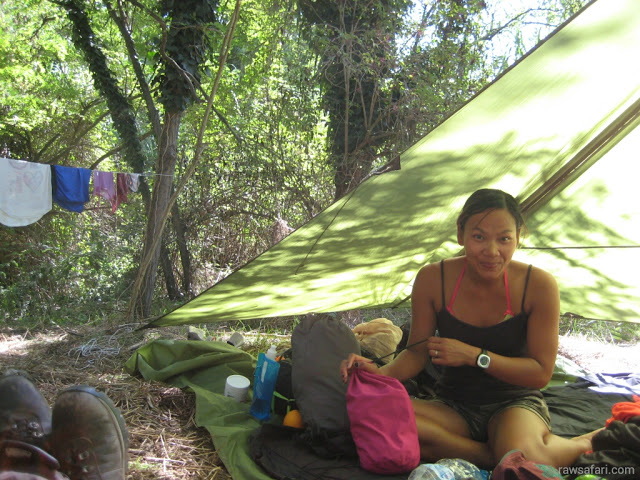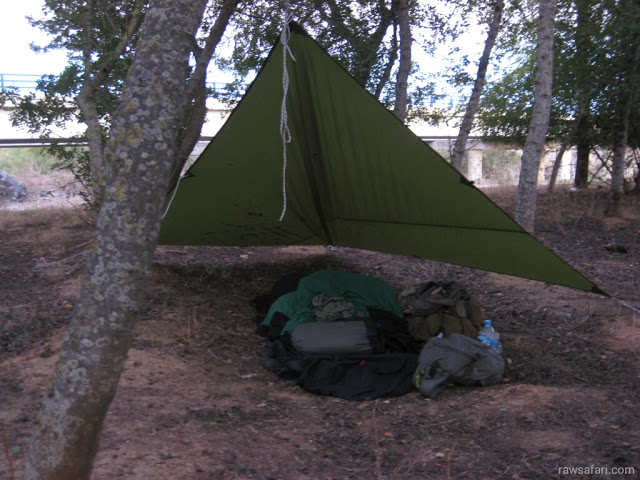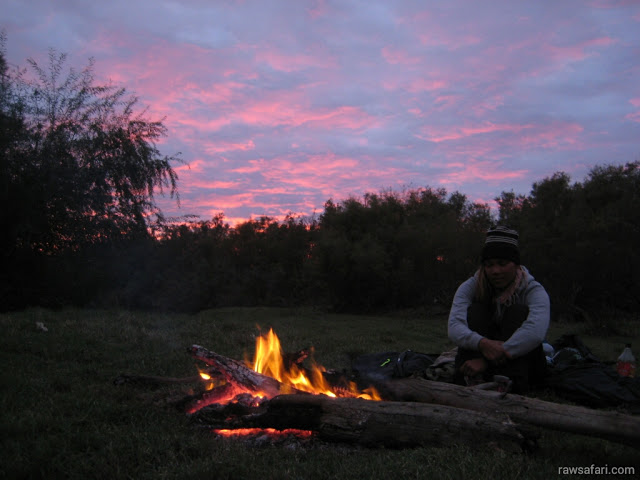>> This article has been updated. Read the latest version here.
…The main reason for camping when you travel, is saving money… every time I fork out money for a hotel room, I’m thinking of the places I could go, the exotic food I could eat, and the exciting things I could do with that money instead…
Being a Boy Scout guaranteed my nerd status as a kid, but I did learn some useful stuff about camping. Since then I’ve camped in all sorts of places: on beaches; riverbanks; sand dunes; cemeteries; vacant lots; railway yards; roadsides and parks.
Most people think of camping as something you do in forests, or in “camping grounds”, where you pay for a space to pitch your tent, but you can camp ANYWHERE.
(Above: urban camping in Manresa, Spain, with Nia.)
Why would I want to camp out?
The main reason for camping when you travel, is saving money. In many parts of the world cheap hotels are widely available, but in places like Europe, the U.S.A. and Australia, hotels are relatively expensive.
For me, every time I fork out money for a hotel room, I’m thinking of the places I could go, the exotic food I could eat, and the exciting things I could do with that money instead. A bed is a bed is a bed. Some are fancier, some are cleaner, but in the end, you sleep in them, and sleep isn’t value for money in terms of travel experience.
The second reason I camp out is aesthetic. I love the outdoors, and there is a feeling I get when I’m curled up by my campfire, with a sky full of stars above me, that no hotel can provide.
Finally, camping makes you independent. I hitchhike, and I rarely know exactly where
I will be at the end of the day. It’s exciting, but it means sometimes where I end up is a long way from the nearest motel. Being prepared to camp comfortably and safely means I am never anxious about where a days travel will take me. If I can find a spot to unroll my bivvy, I will be warm and dry.
What is urban camping?
Urban camping is a specialised skill set. Most of the camping basics still apply, but the additional factor is visibility. When camping in an urban setting, the goal is to disapear.
A visible urban camp site will attract unwanted attention and make you vulnerable to harassment. If you are unseen, you will avoid problems with people in authority, such as police and rangers, and be secure from theft and vandalism. If nobody knows you’re there, no-one will give you any hassles, and you can enjoy your camp site in peace and quiet.
To blend in and disappear in an urban setting, you need to consider two things: location and camouflage.
Choosing a camp site location.
Finding the right spot is the most important aspect of successful urban camping.
Choosing a camp site is all about observation. A good urban camp site must have 3 important features:
1. it must be relatively close to the attractions of the town and sources of food and water
2. it should be hidden and not too close to footpaths or houses
3. it must be dry, and not susceptible to flooding in the case of sudden rain
When looking for a camp site, in an unfamiliar urban area, the first thing to do is consult a map. If you have a GPS mapping app, like “Map Factor“, you can quickly and easily find out exactly where you are. If you are doing things old school, obtain a tourist map of the town from an information centre or hotel.
Once you know where you are, look for areas on the map that offer the best opportunities for camping. Identify features such as green zones, freeways, water courses, and vacant land.
Often, vacant land suitable for camping can be found on the edge of bodies of water: beaches; rivers; creeks; and lakes. It’s always nice to be near water when you camp, so you can freshen up in hot weather. (Note: Do not camp in dry creek beds. One hour of heavy rain, and you could find yourself in deep water.)
Large roadways such as motorways and train lines often have areas of waste ground or green zones beside them
where you can camp.
Suburban sports fields often have lightly wooded ground on their margins suitable for camping.
Parks and reserves are often camp-able. Look for wooded or overgrown areas, off the footpaths, and away from street lighting. For an overnight camp, even a small suburban park is often OK if you pick the right spot, amongst shrubs or trees.
Look for areas that are not lit up at night. Find places that are lightly overgrown, with long grass, or bushes to screen your camp site from passers-by.
Improvise and observe. Study your surroundings and investigate any areas that look dark and quiet. Some camp sites are OK for one night, others are good for a week. It all depends on the circumstances.
When you choose a camp site, look for tell-tale signs of foot traffic, like well worn paths, garbage, or other traces of people using the area. Moving your camp five metres might make the difference between invisibility, and having some drunk tripping over you in the middle of the night.
Especially in regions where poverty is an issue, attractive camp sites may also be favorite places for homeless people to sleep, so look for signs of habitation like mattresses and empty bottles before you settle.
When you are in an unfamiliar area, it is a good idea to scout for potential camp sites before dark, when it is easier to find your way around. Identify one or more locations and mark them on your map. If your chosen site is deep in undergrowth, leave an unobtrusive marker to help you find the spot again later, such as a twig stuck in the ground, or a stack of stones beside the path. After nightfall, when you are less likely to be observed, you can easily return to the spot.
Camouflage.
Being invisible is key to successful urban camping. If you are unobserved you will avoid any hassles.
The human eye is instinctively drawn to regular shapes, straight lines, and bright colours. Camouflage depends on avoiding these visual tell-tales.
Use organic colored, or black gear and clothing. The best colours are dark green, brown, black and charcoal grey. Avoid light colours or reflective materials that will show up at night.
Use a red coloured flashlight, which is harder to spot from a distance.
A camp fire will draw attention, so only light up if your camp site is really well hidden.
Try to avoid being seen entering, or leaving your camp.
Check the appearance of your camp from an outside point of view, to make sure it is not drawing attention. Avoid camping on ridges where your shelter will stand out on the horizon.
Use natural elements like bushes, trees, long grass etc to screen your camp site. When leaving your camp site for the day, flatten your shelter and hide your gear under grass or tree branches. If you have a quick setup shelter like a tarp, strike your camp every morning, and conceal your gear completely. Use twigs, or bunches of grass to conceal your camp by scattering them over your gear.
Pitching camp.
Whether you use a simple bivvy, a compact tent, or tarp, you will want to find the flattest ground available to set up on.
Check carefully with gloved hands for any sharp objects such as broken glass, sticks, brambles etc, that may damage your shelter or bedding.
Avoid camping in ditches, causeways or swampy areas that may flood in case of rain. Never camp in culverts or drains, however tempting they may be from the point of view of concealment. Many countries have dyke systems to control surface water flows, and an opened gate can mean a flash flood.
Do not camp in tidal zones such as beaches and estuaries. Tides can move quickly. Beaches often have excellent camping opportunities above the high tide line. To be sure you are in a safe area, look for consistent plant growth, and observe tidal erosion patterns on the beach.
Get started.
Urban camping is a fun and versatile form of accommodation for the adventurous traveler. With the right gear and a bit of simple know-how, you can save yourself a lot of money. What do you do with all that extra money? Travel more, of course!
If you’ve got questions, or you have some handy urban camping techniques of your own you’d like to tell me about, please comment below, or email me! Happy trails!
>> Get the right camping gear.
>> How to travel France for $11 / day.
>> More about camping.





